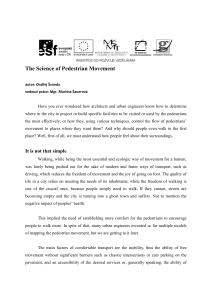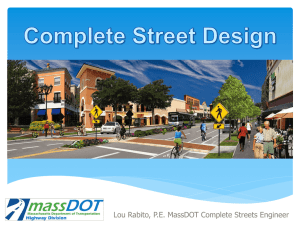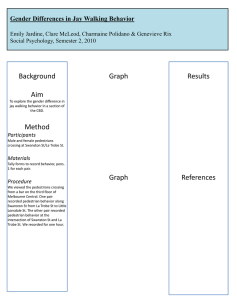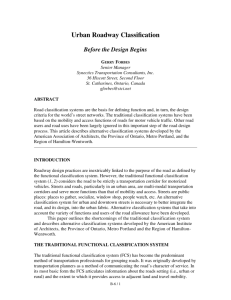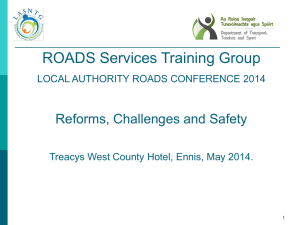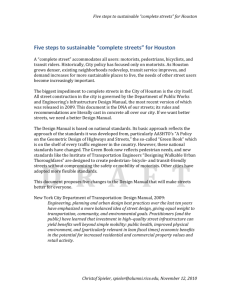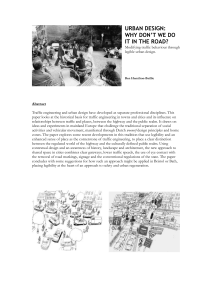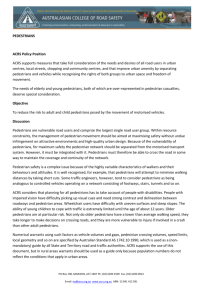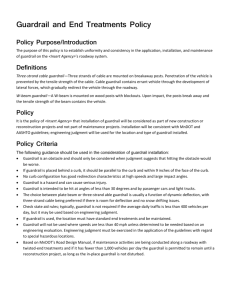PDF - Living Streets
advertisement
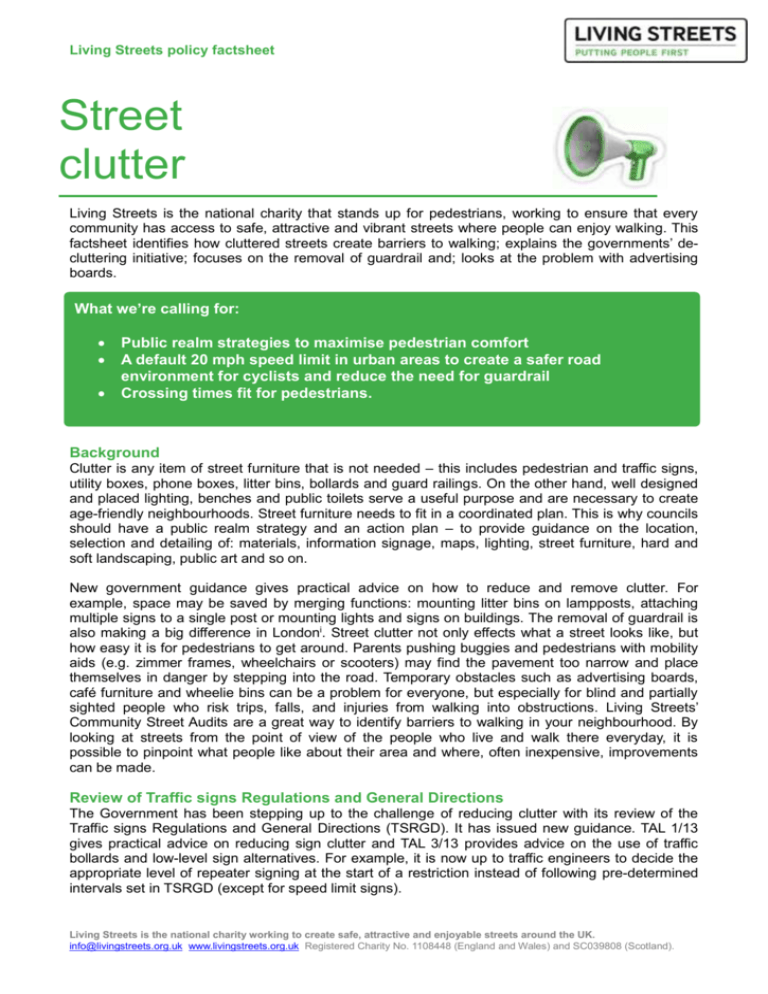
Living Streets policy factsheet Street clutter Living Streets is the national charity that stands up for pedestrians, working to ensure that every community has access to safe, attractive and vibrant streets where people can enjoy walking. This factsheet identifies how cluttered streets create barriers to walking; explains the governments’ decluttering initiative; focuses on the removal of guardrail and; looks at the problem with advertising boards. What we’re calling for: Public realm strategies to maximise pedestrian comfort A default 20 mph speed limit in urban areas to create a safer road environment for cyclists and reduce the need for guardrail Crossing times fit for pedestrians. Background Clutter is any item of street furniture that is not needed – this includes pedestrian and traffic signs, utility boxes, phone boxes, litter bins, bollards and guard railings. On the other hand, well designed and placed lighting, benches and public toilets serve a useful purpose and are necessary to create age-friendly neighbourhoods. Street furniture needs to fit in a coordinated plan. This is why councils should have a public realm strategy and an action plan – to provide guidance on the location, selection and detailing of: materials, information signage, maps, lighting, street furniture, hard and soft landscaping, public art and so on. New government guidance gives practical advice on how to reduce and remove clutter. For example, space may be saved by merging functions: mounting litter bins on lampposts, attaching multiple signs to a single post or mounting lights and signs on buildings. The removal of guardrail is also making a big difference in Londoni. Street clutter not only effects what a street looks like, but how easy it is for pedestrians to get around. Parents pushing buggies and pedestrians with mobility aids (e.g. zimmer frames, wheelchairs or scooters) may find the pavement too narrow and place themselves in danger by stepping into the road. Temporary obstacles such as advertising boards, café furniture and wheelie bins can be a problem for everyone, but especially for blind and partially sighted people who risk trips, falls, and injuries from walking into obstructions. Living Streets’ Community Street Audits are a great way to identify barriers to walking in your neighbourhood. By looking at streets from the point of view of the people who live and walk there everyday, it is possible to pinpoint what people like about their area and where, often inexpensive, improvements can be made. Review of Traffic signs Regulations and General Directions The Government has been stepping up to the challenge of reducing clutter with its review of the Traffic signs Regulations and General Directions (TSRGD). It has issued new guidance. TAL 1/13 gives practical advice on reducing sign clutter and TAL 3/13 provides advice on the use of traffic bollards and low-level sign alternatives. For example, it is now up to traffic engineers to decide the appropriate level of repeater signing at the start of a restriction instead of following pre-determined intervals set in TSRGD (except for speed limit signs). Living Streets is the national charity working to create safe, attractive and enjoyable streets around the UK. info@livingstreets.org.uk www.livingstreets.org.uk Registered Charity No. 1108448 (England and Wales) and SC039808 (Scotland). Guardrail removal Guardrail creates a barrier between pedestrians and where they want to go (their desire lines), increasing walking distances and constraining pedestrian movement (e.g. on traffic islands). The use of guardrail may also reduce usable footway space leading to congestion. There is a perception that guard rails increase pedestrian safety – for example, at pedestrian crossings or in front of schools. However, Local Transport Note 2/09 notes that ‘there is no conclusive evidence that the inclusion of pedestrian guardrailing at any type of pedestrian crossing or junction has any statistically significant effect on the safety record’ii. Instead, guardrail contributes to traffic dominating the street scene, encouraging aggressive driver behaviour and increased vehicular speedsiii. Alternatives to the installation of guardrail include: reducing speed limits, traffic calming, relocating or installing new pedestrian crossings to fit with desire lines, installing bollards, and footway improvement and widening. Control of advertising boards London TravelWatch’s report Inclusive Streetsiv (2013) advocates clear and accessible pavements, in particular, the complete removal of obstructions caused by advertising boards (A-boards). It argues that there is ‘no lawful excuse for causing obstruction with an advertising board’. In practice, A-boards are widely used and are either a) unregulated, b) licensed (and so condoned) or in rare cases c) banned (e.g. in Kingston upon Thames). While recognising that A-boards can be a real nuisance for pedestrians, Living Streets does not advocate a complete ban. This is because we believe such a ban may be unenforceable, whereas licensing enables local authorities to pay for the enforcement of minimum standards (e.g. available pavement width, sign size, placement etc.). Additional Resources: To find out more about pedestrian friendly street design read the Manual for Streets www.gov.uk/government/publications/manual-for-streets and Manual for Streets 2 http://www.ciht.org.uk/en/knowledge/publications/index.cfm Find out more about Islington Living Streets’ 20 mph success story and campaign resources www.livingstreets.org.uk/20mphislington Take action on crossings through our campaigns pages www.livingstreets.org.uk/safercrossings For more information please contact Rachel Lee: rachel.lee@livingstreets.org.uk or call 0207 377 4919 Find out more about Transport for London’s guard rail removal project http://www.tfl.gov.uk/corporate/projectsandschemes/25040.aspx ii Department for Transport Local Transport Note 2/09 – Pedestrian Guardrailing iii Transport for London (2012). Guidance on the assessment of pedestrian guardrail iv Available here http://www.londontravelwatch.org.uk/document/14415 i
